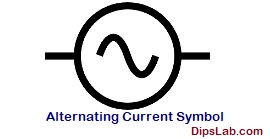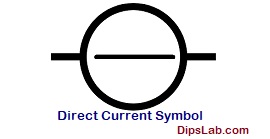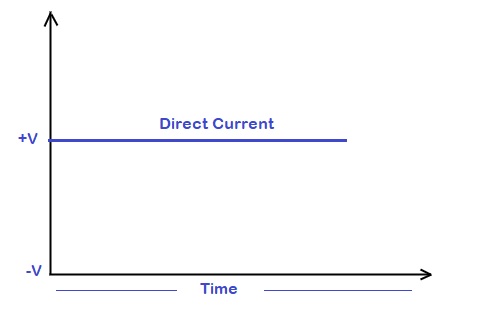
In my earlier electrical current tutorial, I shortly explained alternating current and direct current.
Here, I am describing the multiple specifications of both alternating current (AC) and direct current (DC) with the help of the diagram. Also, we will see AC vs DC.
What is the difference between AC current & DC current?
Here is the difference between the alternating current vs direct current specified in tabular form.
| # | Contents | Alternating Current | Direct Current |
| 01 |
Representation
|
AC represents as Alternating Current. | DC represents Direct Current. |
| 02 | What is alternating current & direct current? | In an electrical and electronic circuit, the current which flows in both directions (with positive and negative lead) at a constant frequency is called ‘Alternating Current’. | In an electrical and electronic circuit, the current which flows only in one direction (with positive lead) is called ‘Direct Current’. |
| 03 | Current | AC flows in a bidirectional way. | DC flows in a unidirectional way. |
| 04 | Voltage | It works on the AC source voltage 110V, 240V, 11kV, 33kV, etc. | It works on DC source voltage 5V, 12V, 24V, etc. |
| 05 | Power | AC source produces real (P) power and reactive (Q) power. | DC source produces only real (P) power. |
| 06 | Frequency | AC has a variable frequency. Usually, it varies from 50 Hz or 60 Hz. | DC has zero frequency. This current doesn’t flow with the frequency. |
| 07 | Direction & Magnitude
(Details in 14 no. point) |
The direction and magnitude of AC are always varying with time. | The direction and magnitude of DC are constant with time. |
| 08 | Resistive | For limiting AC, reactance (X) or impedance (Z) are used. | For limiting DC, only resistance (R) is used. |
| 09 | Types | AC is classified into different types- Sinusoidal, Trapezoidal, Triangular, Square, etc | DC is classified into two types- Pure, Pulsating. |
| 10 | Power Factor | In the AC circuit, the power factor is always from zero (0) to one (1). | In the DC circuit, the power factor is always unity (1). |
| 11 | Waveform | AC wave occurs in the leading or lagging position. | DC wave occurs in a straight forward position. |
| 12 | How current is generated? | AC source is produced by the generator or power generating plant. | DC source is produced by the cell, battery, and solar cells. |
| 13 | Ohm’s Law | The AC circuit does not obey ohm’s law. | DC circuit does obey ohm’s law. |
| 14 | Used | It is used in domestic, commercial, and industrial purposes. | It is used in the electronic circuit and DC appliances. |
| 15 | Transport | AC can be easily transferred to the long-distance by using the transformer. | DC cannot be easily transferred to the long-distance. |
| 16 | Maintenance | It can be easily regulated and maintained. | It can’t be easily regulated. |
17. Symbolic Representation of AC and DC
- Alternating Current (AC) Symbol:

- Direct Current (DC) Symbol:

18. The waveform for AC and DC
- AC Waveform:
The alternating current (AC) waveform occurs in the sinusoidal in nature. Sinusoidal AC wave always varies with time at a constant frequency (50Hz or 60 Hz). You can see in the below alternating current graph.
It flows through the positive phase (+ve terminal) to the negative phase (-ve terminal) with varying frequency and time.

Bi-directional AC Waveform
Mostly, 50 Hz or 60 Hz frequency is used for domestic, commercial, and industrial purposes.
- DC Waveform:
DC waveform occurs in the straight forward and constant in nature. Due to its constant nature, the waveform varies with time in a continuous steady-state direction. You can see in the below direct current graph.
DC doesn’t require the frequency to flow in the circuit. DC is flowing in a unidirectional way (positive terminal) with the time period.

Uni-directional DC Waveform
I have covered most of the difference between alternating current and direct current with the help of specifications, symbols, and graphs.
Here are some more differences you would like to read:
- Electrical vs Electronics
- Series Circuit vs Parallel Circuit
- Electrical Circuit vs Magnetic Circuit
- Resistance vs Reactance
- Capacitor vs Inductor
- Motor vs Generator
- MCB vs MCCB
- Conductor vs Insulator
Hopefully, while going through the difference between AC and DC current, you have cleared your doubts.
If you have any queries or if there is any point you want me to explain, freely drop the comment in the below section.
Thanks for Reading!
Thanks for sharing this type of post.
In the AC circuit, the power factor is always zero (0) or unity (1). My opinion that, PF is between 0 until 1, not 0 or 1.
Thanks, Mizan:)
You are correct. I will edit this point.